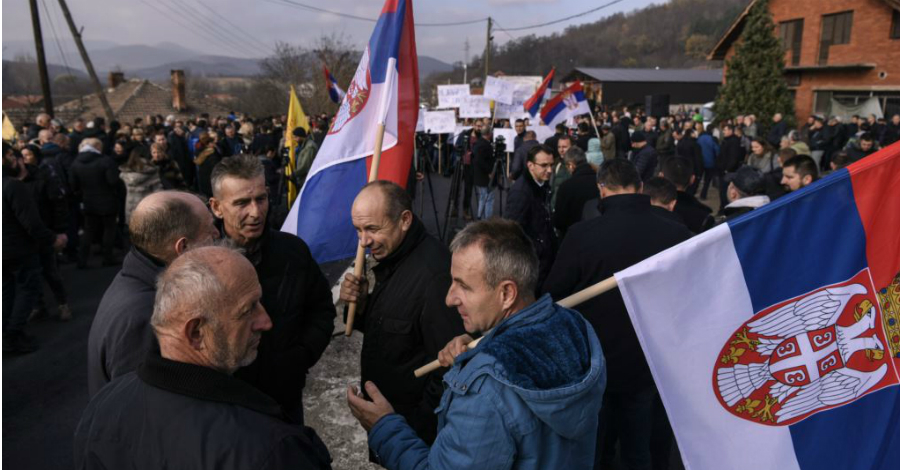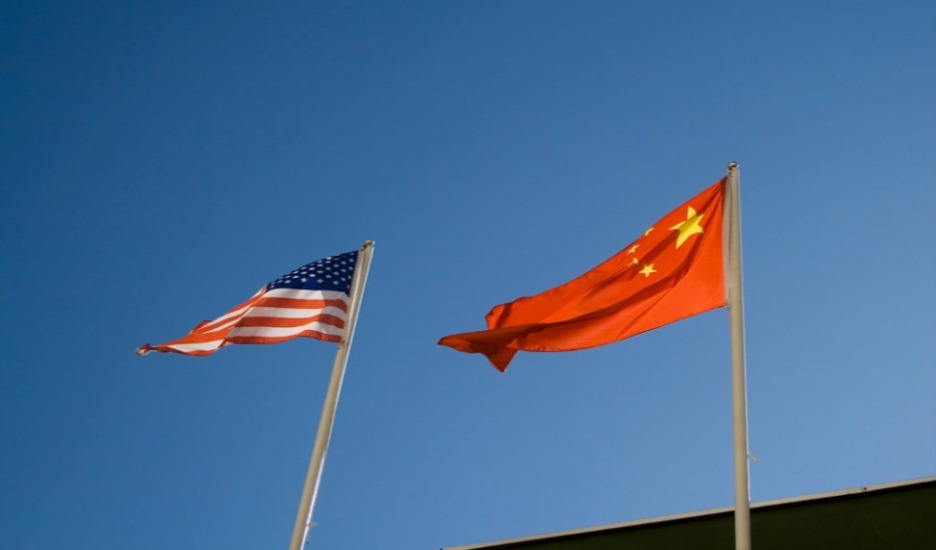Deal or No Deal? International Influence and the Serbia-Kosovo Conflict
Almost three decades after the dissolution of Yugoslavia, the conflict between Serbia and Kosovo continues to be a source of local tension and an issue in international politics. The dispute stems from Serbia’s refusal to recognize Kosovo as a country after Kosovo seceded from Serbia in 2008. The failure to resolve the dispute between Kosovo and Serbia has prevented both countries from joining the European Union (EU).

Published by The Lawfare Institute
in Cooperation With

Almost three decades after the dissolution of Yugoslavia, the conflict between Serbia and Kosovo continues to be a source of local tension and an issue in international politics. The dispute stems from Serbia’s refusal to recognize Kosovo as a country after Kosovo seceded from Serbia in 2008. The failure to resolve the dispute between Kosovo and Serbia has prevented both countries from joining the European Union (EU). Russian President Vladimir Putin has increased Western anxieties about the dispute by aggressively courting Serbia as an ally and even visited Serbia in January to express his solidarity. In March, a top U.S. diplomat, Under Secretary of State for Political Affairs David Hale, visited Serbia and called for Kosovo to lift its tariffs against Serbia. Though a negotiated agreement seemed within reach last year, negotiations have collapsed—creating new openings for diplomatic jockeying between Serbia and Kosovo, and between Russia and the United States
Origins of the Modern Kosovo-Serbia Conflict
The Serbian community won its independence in 1913 in the First Balkan War, but despite the displacement of many Albanians from modern-day Kosovo, they remained the majority in the territory. This demographic trend was reversed when, during World War II, the Axis powers united Kosovo and Albania, shifting the balance of power toward Kosovo’s Albanian population. After World War II, the government of Yugoslavia granted Kosovo the status of an “autonomous province” within the Republic of Serbia, which gave Kosovo control over local functions while still subject to Serbian rule. Over the next few decades, Albanians within Kosovo protested for Yugoslavia to grant Kosovo the status of a full republic. The government of Yugoslavia refused to do so, but it did give Kosovo an increasing amount of control over federal issues within its territory. During this time, Serbians migrated out of Kosovo and Albanian birth rates increased, and by 1991 Albanians made up over 80 percent of Kosovo’s population. The demographic shift contributed to a Serbian narrative that Albanians had forced them out of Kosovo.
After Yugoslavia dissolved in the early 1990s, Slobodan Milošević capitalized on the Serbians’ anger about Kosovo in his campaign for president of Serbia. As president, Milošević committed genocide against Albanians in Kosovo in an effort to make Kosovo a Serbian-majority province. Kosovo officially responded through pacifism under the leadership of Ibrahim Rugova, but a guerilla organization, the Kosovo Liberation Army, also engaged in violent resistance. In response to the conflict, the United Nations engaged Serbia and Kosovo in peace talks while NATO intervened with U.S.-led peacekeeping forces. This intervention stopped the violence, but tensions remained between Kosovo and Serbia and the issue of governance in the territory was not fully resolved.
Over the next decade, the U.N. tried to broker a plan for Kosovo to gain self-rule but failed to come up with a concrete plan. In 2008, Kosovo unilaterally declared independence. Serbia immediately responded that Kosovo’s declaration was illegal and challenged its independence in the International Court of Justice (ICJ). Two years later, the ICJ ruled that Kosovo’s declaration of independence was legal. Since the 2008 declaration, 108 countries, including the United States, have recognized Kosovo as an independent nation, but Kosovo still falls short of the two-thirds majority required for U.N. recognition. Serbia’s refusal to recognize Kosovo remains a sticking point. Russia and China, among others, have backed Serbia’s claim that Kosovo is not an independent nation. Many of these countries claim they will support whatever stance Serbia takes regarding Kosovo.
Recent Negotiations
Since 2013, Kosovo and Serbia have engaged in EU-mediated peace talks. The EU’s goal for these talks is to persuade Serbia to recognize Kosovo’s independence, which the EU has made a precondition for both countries to join the union.
In September 2018, the talks gained new momentum when a plan was introduced to revise the Serbia-Kosovo border so that significant pockets of Serbians in Kosovo could live in Serbia and vice versa. The proposal has generated some criticism, including from European leaders; as the plan took shape German Chancellor Angela Merkel said she opposed the idea on the basis that it would reopen conflicts from the 1990s. Despite Merkel’s opposition, Serbian President Aleksandar Vucic was scheduled to meet with Kosovo’s president, Hashim Thaci, in September. However, when the day came for Vucic and Thaci to meet, they abruptly refused to talk with each other.
The apparent progress toward a deal unraveled quickly. A few days later, Vucic visited Kosovo to address the Serbian minority. During the visit, Vucic praised Milošević, which the Kosovo government viewed as a provocation. The next month, Serbian diplomats convinced Interpol to reject Kosovo’s bid to join the international police network. Kosovo responded by placing a 100 percent tax on imports from Serbia. Both Serbia and the EU then accused Kosovo of violating the Central European Free Trade Agreement (CEFTA). Kosovo increased tensions further in December with a parliamentary vote authorizing the creation of a national army. Nikola Selakovic, an advisor to Vucic, said the move could lead to Serbia invading Kosovo. The diplomatic sparring has left the two countries at an impasse: Kosovo will not lift the tariffs until Serbia recognizes its independence, and Serbia will not participate in talks until Kosovo lifts the tariffs.
Officials from the EU and the United States have continuously called for Kosovo to lift the tariffs since they were imposed in November. Additionally, after North Macedonia followed through in January on a plan to change its name to resolve a long-running dispute with Greece, officials from the EU voiced hope in February that Kosovo and Serbia could work out a similar deal.
Not only has Kosovo resisted the calls for lifting the tariffs, Thaci recently rejected the border-swap plan that he was ready to negotiate in September. Vucic has expressed optimism for a deal in the long term but has waved back hope that the momentum from North Macedonia and Greece’s deal could carry over to Kosovo and Serbia. The Kosovo and Serbia dispute “cannot be compared,” he said in February. “It’s 100 times more difficult.”
Russia’s Balkan Interests
As talks have stalled between Kosovo and Serbia, Russia has become more engaged in the dispute. Russian relations with Serbia have at times been tense, a continuation of Russia’s tumultuous relationship with Yugoslav leader Josip Broz Tito, but the tensions between Kosovo and Serbia since Kosovo’s 2008 independence declaration have given Russia a new opportunity to establish a friendlier relationship with Belgrade. Russia has consistently sided with Serbia to oppose Kosovo’s independence in 2008. Russia’s foreign policy toward Serbia and Kosovo fits a broader pattern. Putin has sought to make inroads with other Balkan nations as well, because he views Western European and U.S. presence in Russia’s near abroad as a threat. Putin failed to stop Montenegro from joining NATO; now he hopes to keep other Balkan nations, including Serbia, from joining the U.S.-backed alliance.
Russia started courting Serbia in 2014, when Russia stoked ethnic fears in Serbia by spreading fake news reports through radio programs and billboards that claimed Islamic organizations and the EU were conspiring against Serbia. The Pentagon saw this effort as a way to counter EU and U.S. condemnation of Russia invading Crimea by Russia strengthening its relationship with allies that did not oppose them. After the invasion, Russia started aggressively courting all of the Western Balkan nations. Russia has particularly provided Serbia with military and economic aid, and natural disaster relief.
Russia has also continued to bolster Serbia in its dispute with Kosovo. While on a visit to Serbia in January, Putin criticized Kosovo’s establishment of an army as illegal and blamed the dispute between Kosovo and Serbia on meddling by the United States and Western Europe. He also threatened to join talks between Kosovo and Serbia if the United States joins. Though there has been no concrete talk of the United States joining talks, U.S. diplomats have met with leaders of both countries and President Trump has offered to host a peace ceremony if the two countries reach a deal.
Russia’s courting of Serbia has paid off. In 2017, Vucic pledged never to levy sanctions against Russia—which could threaten Serbia’s accession to the EU. Russia’s influence over Serbia is not absolute, though. That same year, Serbia’s prime minister, Ana Bnarbic, said that if given the choice between the EU and Russia, Serbia would choose the EU. In a poll published by the newspaper Politika last year, 58 percent of Serbians listed Putin as the foreign leader they trusted most. When Putin visited Serbia in January, the government set up an elegant ceremony with Russian colors and bussed in thousands of citizens from throughout the country to welcome Putin. Back in 2014, when Russia began to court Serbia, experts believed Serbia was hedging its bets between Russia and Western states. Putin’s “rock star” reception has caused some to wonder if Serbia is actually embracing Russia due to its frustration with the West being too imposing, while others insist that Serbia is still just playing both countries and ultimately still hopes to join the EU. Vucic admitted to using Russia to needle the West when he said the West would “become even more tolerant toward his autocratic behavior, in the hope that he doesn’t drop Serbia’s formal commitment to join the E.U.”
Regardless of Serbia’s true intentions, Putin wants to pull Serbia into Russia’s corner to disrupt what he views as Western dominance in the region. In the last year, Montenegro has joined NATO and Macedonia changed its name to North Macedonia, setting the stage for it to join NATO as well. Putin hopes that any country not in NATO and/or the EU will be willing to serve as an ally to counter the West. If Serbia joins the EU, then Russia will not be able to use it to counter Western domination in Eastern Europe. Some experts have told the New York Times that Putin “would privately express dismay at Belgrade’s eagerness to join the European Union.”
Kosovo has had mixed reactions to Russia’s involvement in the dispute. In February, Thaci expressed confidence that Russia would support any reconciliation deal reached by Serbia and Kosovo. However, that same month, Kosovo Prime Minister Ramush Haradinaj said that Russian aggression served as a major threat to reconciliation with Serbia.
The U.S. Role and the Shadow of the NATO Intervention
U.S. involvement in the region has been particularly contentious since 1999, when the United States led a NATO air campaign to stop Milošević’s ethnic cleansing of the Albanian population. The bombings ultimately drove Milošević out of power but made many Serbians view the United States as an aggressive oppressor. In 2018, a Gallup poll found that 58 percent of Serbians disapproved of U.S. leadership in the world, compared to just 16 percent who approved.
Conversely, the citizens of Kosovo adore the United States. The same poll found that 75 percent of the citizens in Kosovo approve of U.S. leadership. There is also an 11-foot statue of Bill Clinton in Pristina, the capital of Kosovo, and many businesses and streets there are named after an array of U.S. politicians.
The United States has largely taken the EU’s position that Serbia and Kosovo should work out their differences and then join the EU. However, the United States has broken with some partner countries and organizations over specifics of its Kosovo policy. In August 2018, National Security Adviser John Bolton announced that the United States would not oppose the EU plan to revise Kosovo and Serbia’s borders, despite Germany’s concerns. The United States also backed Kosovo’s plan to create an army, right after the secretary general of NATO came out against the Kosovo parliament’s decision.
In July 2018, in response to increasing Russian interference in the Balkans, the U.S. stepped up its efforts to counter Russia’s influence in the region. Then-U.S. Defense Secretary James Mattis met with the defense chiefs of all Balkan countries, including Serbia. Though Mattis did not name Russia at the meeting, he mentioned its intervention in the region when he said that “those that seek to divide us for their own reasons will not enjoy our dedication to working together.”
In November 2018, the White House hosted Thaci and both Secretary of State Mike Pompeo and Bolton met with Thaci. After the meeting, Bolton and Pompeo publicly called on Kosovo and Serbia to end their dispute.
In December 2018, President Trump sent a letter to Thaci and Vucic that urged the two leaders to strike a deal and even offered to host the two leaders at the White House. Kosovo Prime Minister Haradinaj responded with praise for Trump and said he agreed a deal was close. Vucic said that, though he appreciated Trump’s optimism, he felt Serbia and Kosovo “are far from any kind of agreement.”
In February, Pompeo said that the United States would take more interest in Eastern Europe overall and warned that Russia was trying to divide Western nations.
In early March, a few weeks after Putin’s visit to Serbia, the U.S. undersecretary of state for political affairs met with Vucic and called for Kosovo to lift its tariffs on Serbia. Although Haradinaj continues to resist the calls to lift tariffs, Thaci expressed hope in February that Kosovo could reach a trade deal with Serbia this year.
Serbia and Kosovo remain at a standstill over a possible deal. Russia has seen an opening from this dispute and has tried to pull Serbia away from the EU and the United States through state visits and increased economic benefits for Serbia. The new military threats from Serbia in response to Kosovo’s creation of an army add further tension in the region. How the dispute—and the diplomacy to resolve it—proceeds will depend on whether the United States acts on its rhetoric and takes a more active role to counter Russia’s efforts to project influence in the Balkans.


.jpg?sfvrsn=5a43131e_9)


